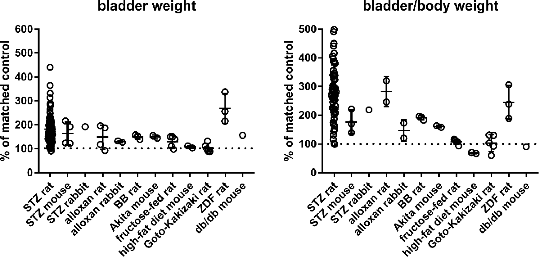| 011P London, UK Pharmacology 2017 |
A comprehensive analysis of urinary bladder hypertrophy in animal models of diabetes mellitus
Introduction: Enlargement of the urinary bladder has repeatedly been reported in rats following injection of streptozotocin (STZ), the most frequently used model of type 1 diabetes mellitus (T1DM). However, it remains unclear whether this can be extrapolated to other models of T1DM and T2DM or to diabetic patients. Therefore, we have performed a comprehensive analysis of bladder hypertrophy across animal models of diabetes.
Method: A PubMed search with the keyword combination “diabetes” “bladder” and “hypertrophy” was performed; reference lists of publications were scanned for additional references. As many diabetes models are associated with decreased or increased body weight, we concomitantly assessed bladder hypertrophy as bladder weight (BW) or as bladder/body weight ratio (BBW), each being expressed as % of the control group within the same study. The full text of each study was extracted for information on diabetes model, severity (blood glucose level, BG) and duration of diabetes, species, sex, body weight and BW. Data are shown as scatter plots and means ± SD.
Results: A total of 62 studies reporting on bladder hypertrophy were identified, of which 38 used STZ-injected rats. As some studies reported on multiple time points, a total of 104 comparison (72 from STZ rats) were available for analysis. Bladder hypertrophy was found consistently in STZ-treated rats (BW 182±64%, BBW 283±52% of control), except time points earlier than 1 week after injection. Therefore, only data at least 1 w after diabetes induction was included in the analysis shown in the figure. Normal 0 21 false false false TR X-NONE X-NONE /* Style Definitions */ table.MsoNormalTable {mso-style-name:"Normale Tabelle"; mso-tstyle-rowband-size:0; mso-tstyle-colband-size:0; mso-style-noshow:yes; mso-style-priority:99; mso-style-parent:""; mso-padding-alt:0cm 5.4pt 0cm 5.4pt; mso-para-margin:0cm; mso-para-margin-bottom:.0001pt; mso-pagination:widow-orphan; font-size:10.0pt; font-family:"Times New Roman",serif; mso-ansi-language:EN-GB; mso-fareast-language:EN-GB;} Hypertrophy was similar across sexes and STZ doses (35-40 vs. 50-65 mg/kg) but appeared greater with Wistar rats than other rat strains. Bladder hypertrophy among STZ-rats was not correlated to BG, but moderate correlations were found between BW and BBW on the one and BG on the other hand were found across models (r2 0.1774 and 0.3992, respectively).

Conclusion: We conclude that bladder hypertrophy is a consistent feature of STZ-rats but less pronounced or even absent in other models of T1DM or T2DM (shown in figure). The relationship between diabetes severity and extent of hypertrophy is moderate at best, indicating that other, possibly model-specific factors, may play a role.

